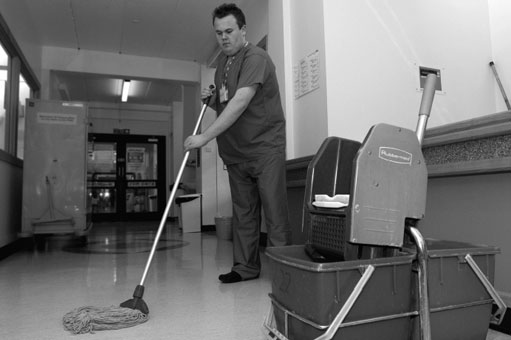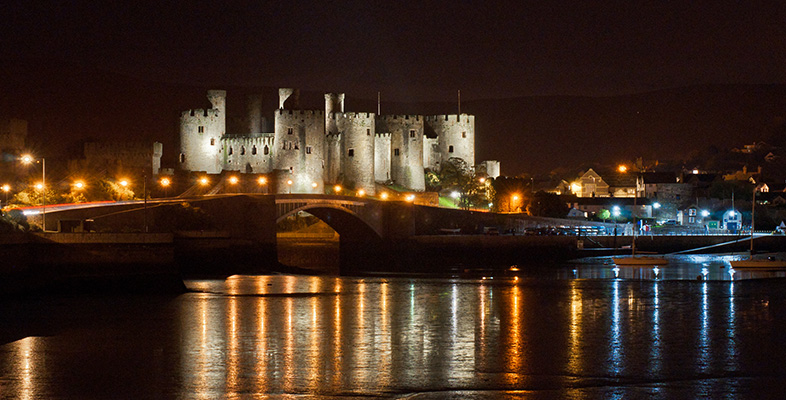3.1 Economy and work in contemporary Wales
This section provides a review of the current Welsh economy and world of work.
Activity 6
Take a moment to reflect on what images you might already have of work in Wales.
What are the representations of working lives in Wales that you’ve encountered in film and literature.
How is the Welsh economy presented in the mass media.
Note three dominant images you associate with work and employment in Wales.
Discussion
I can say with almost certainty that one of your images will be of a miner with helmet and Davy lamp, or perhaps black-faced and cloth-capped. A second image might be that of a steelworker, silhouetted against the glow of a furnace and sparks of molten steel. A third might be that of a solitary sheep farmer, carving a meagre existence high in the hills of north Wales. Did you also think of a Welsh ‘Mam’, perhaps picturing her in sepia brown, leaning in the doorway of her ‘little palace’, whose work in the domestic realm underpins the more visible labour of her men folk?
In many ways these have become stereotypical images of Wales, replicated in literature, art, film, photography and television. However, the modern Welsh economy is a diverse and complex mix of activities which range from heavy industrial production to industries characterised by innovative uses of high technology. Wales remains one of the UK regions with the highest dependence on manufacturing industry and, although the significance of steel manufacturing and heavy fabrication has declined, other forms of industrial manufacturing have taken their place. Some of the high-profile modern activities include the manufacture of European Airbus aircraft wings at Broughton in north Wales and the production of car engines at Bridgend in south Wales. The policy of attracting inward investment to Wales has ensured the presence of the manufacture of textiles, electronics, automotive components and consumer goods. Consequently, for many people in Wales the experience of work centres on a factory, with 10 per cent of the workforce employed in manufacturing processes in 2012.
Whilst the number and proportion of workers in manufacturing has been falling, the growth has been in the service sector – which encompasses the public services (e.g. health and education), wholesale, retailing, distribution and transport, banking and finance and leisure. In 2012, about 86% of the jobs in Wales are in the service sector. Table 1 shows the distribution (in 2012) of employment in the different industrial sectors in Wales.
| Industrial sector | Number | Percent |
|---|---|---|
| Agriculture, forestry and fishing | 35,600 | 2.7 |
| Mining and quarrying | 2,200 | 0.2 |
| Manufacturing | 130,300 | 9.9 |
| Electricity, gas, steam and air conditioning supply | 6,600 | 0.5 |
| Water supply; sewerage, waste management and remediation activities | 12,500 | 0.9 |
| Construction | 89,700 | 6.8 |
| Wholesale, retail, transport, hotels and food | 342,000 | 25.9 |
| Information and communication | 25,900 | 2.0 |
| Finance and insurance activities | 30,900 | 2.3 |
| Real estate activities | 18,500 | 1.4 |
| Professional, scientific and technical activities; administrative and support service activities | 136,400 | 10.3 |
| Public administration and defence, compulsory social security | 87,600 | 6.6 |
| Education | 129,100 | 9.8 |
| Human health and social work activities | 200,600 | 15.2 |
| Other service activities – arts, entertainment and recreation | 39,400 | 3.0 |
| Other service activities –other industries | 32,200 | 2.4 |
| 1,319,500 | 100 |
Footnotes
Welsh Assembly Government (2013)Three key problems facing the contemporary Welsh economy can be identified (Bryan and Roche, 2009). The first of these is Wales’s consistent underperformance in comparison with the majority of other UK regions. The economic output of a region is usually measured in terms of its gross value added (GVA) [Tip: hold Ctrl and click a link to open it in a new tab. (Hide tip)] .
Wales produces goods and services at only 72 per cent of the GVA for the UK (in 2013), with the Isle of Anglesey and the Gwent Valleys measuring lowest at 49 per cent and 57 per cent, respectively. This gap is also gradually widening despite the major European Union (EU) investment of structural funds. Qualification for these funds relies on gross domestic product (GDP) in Wales being below 75 per cent of the UK average. This has been described as ‘a badge of failure’ (Hill, 2000, p. 1); it marks Wales as one of the poorest regions in Europe prior to the recent addition of the eastern European succession states. Regrettably, the use of this initial round of European funding did not significantly change the level of GDP in Wales and a new round of funding was allocated in 2008. Now referred to as ‘convergence funding’, this is being deployed more strategically than the Objective 1 programme. With convergence funding, the Welsh Government. plays a central role in how the money is used, in contrast to the more devolved model that saw local government and third-sector organisations heavily involved.
However, despite such interventions the economic performance in Wales remains poor. A key reason for this is the second major problem in the contemporary Welsh economy: the low employment rate. This figure is distinct from the unemployment rate, which simply measures the numbers of people seeking work. Instead, the employment rate measures those in work as a proportion of the full population of working age. The employment rate informs us about all forms of economic inactivity, including unemployment, premature retirement and those prevented from working by illness or incapacity. Wales consistently has the lowest employment rate in the UK, with the exception of the north-east of England. This simply means that more people of working age in Wales are economically inactive and are not currently seeking. This is a critical weakness in the Welsh economy and prevents improvements in output. The social consequences of high rates of economic inactivity are explored later in this section.
The final key problem in the Welsh economy is the general prevalence of lower wage levels than elsewhere in the UK (see Figure 4). Although there is variation between different sectors of the economy, the overall pattern is that average earnings in Wales reach only 87 per cent of the UK level. In the UK in April 2013, average gross weekly earnings were £620 in comparison with the Welsh average of £539 and this demonstrates a slight widening of the gap, in recent years. Low wages have become the primary cause of poverty in Wales, rather than unemployment – which triggered poverty for the majority of people in the 1990s. However, the effects of the recession that began in 2007, and the impact of the Liberal-Conservative Coalition government’s austerity measures are seeing unemployment returning as a major cause of poverty.

To return to our images of Wales and the pattern of work, we can see that the economy of Wales is now far more complex than we might have imagined and that there are core structural problems in the Welsh economy which present major challenges for the government in Wales, but most critically for the people who experience worklessness and low wages. The images of miners, steelworkers and farmers no longer adequately describe the contemporary world of work and employment in Wales. The image of the Welsh ‘Mam’ also belongs in the past, as the economic activity rates of women continue to rise. In order to fully understand the transformations which have taken place it is necessary to trace the major changes in economic activity in Wales since the Second World War. The economy we experience today and the patterns of work we observe are the legacy of major processes of economic and social change. These are considered in the next section of this course.
